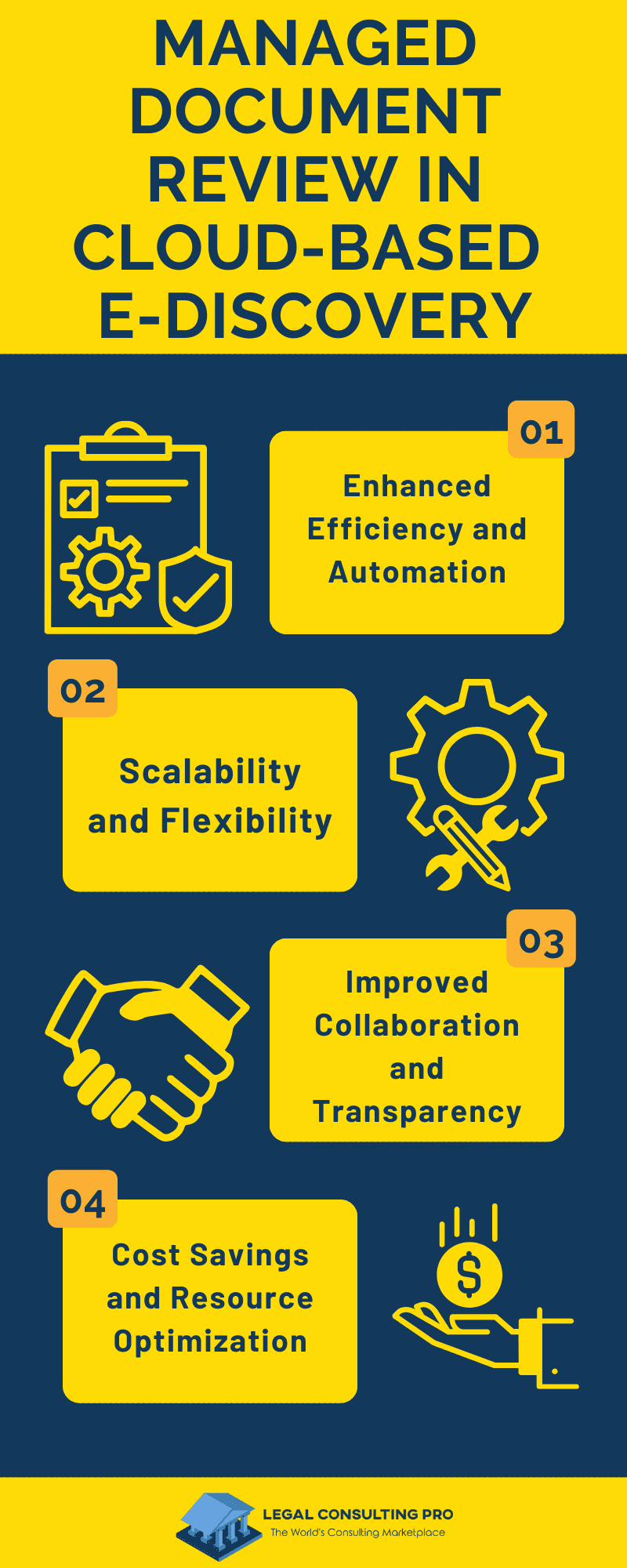The legal industry is undergoing a digital transformation, and one of the most significant developments in recent years is the adoption of cloud-based e-discovery solutions. E-discovery, or electronic discovery, refers to the process of identifying, collecting, and producing electronically stored information (ESI) in response to a request for production in a lawsuit or investigation. Cloud-based E-Discovery offers numerous advantages for legal teams, including enhanced efficiency, cost savings, and improved data security. However, these benefits come with certain considerations that must be addressed to ensure successful implementation and compliance with legal standards.
Advantages of Cloud-Based E-Discovery Solutions
Enhanced Efficiency
One of the primary advantages of cloud-based E-Discovery is the significant improvement in efficiency. Traditional e-discovery processes often involve manual, time-consuming tasks such as sorting through vast amounts of data, managing physical storage devices, and coordinating among various stakeholders. Cloud-based solutions streamline these processes by automating many of the tasks involved in e-discovery, reducing the time and effort required to complete them.
Cloud-based platforms provide centralized repositories for ESI, allowing legal teams to access and search data from anywhere with an internet connection. This accessibility eliminates the need for physical data transfers and enables real-time collaboration among team members, regardless of location. As a result, legal teams can respond more quickly to discovery requests and meet tight deadlines with greater ease.
Cost Savings
Cost savings are another significant advantage of cloud-based e-discovery solutions. Traditional e-discovery processes often require substantial investments in hardware, software, and personnel. Legal teams must purchase and maintain servers, storage devices, and other IT infrastructure to manage and store ESI. Additionally, the costs associated with manual data processing, such as labor and time, can be considerable.
Cloud-based E-Discovery offers a more cost-effective alternative by eliminating the need for expensive on-premises infrastructure. With cloud-based solutions, legal teams can leverage the scalability of cloud services to adjust their storage and processing capacity as needed, paying only for the resources they use. This pay-as-you-go model reduces upfront capital expenditures and ongoing maintenance costs, making e-discovery more affordable for organizations of all sizes.
Improved Data Security
Data security is a critical concern in e-discovery, given the sensitive and confidential nature of the information involved. Cloud-based e-discovery solutions offer enhanced security features that help protect ESI from unauthorized access, loss, and breaches. Leading cloud providers implement robust security measures, such as encryption, multi-factor authentication, and regular security audits, to safeguard data.
In addition to these technical measures, cloud-based solutions often include advanced access controls and permissions management, allowing legal teams to restrict access to sensitive information on a need-to-know basis. This level of control helps prevent data leaks and ensures compliance with data protection regulations, such as the General Data Protection Regulation (GDPR) and the California Consumer Privacy Act (CCPA).
Scalability and Flexibility
Cloud-based E-Discovery offers unparalleled scalability and flexibility, allowing legal teams to adapt to changing requirements and workloads. In traditional e-discovery environments, scaling up to handle large volumes of data often involves significant investments in additional hardware and software, which can be both time-consuming and costly.
With cloud-based solutions, legal teams can quickly scale their storage and processing capabilities up or down based on their needs. This flexibility is particularly valuable in large, complex cases or sudden spikes in data volume, where the ability to adjust resources rapidly can make a significant difference in meeting deadlines and managing costs.
Learn more: E-Discovery Solutions 101: A Comprehensive Guide to Electronic Discovery Solutions

Considerations for Implementing Cloud-Based E-Discovery Solutions
While the advantages of cloud-based E-Discovery are compelling, there are several considerations that legal teams must address to ensure successful implementation and compliance with legal standards.
Data Privacy and Compliance
One of the primary considerations for legal teams when adopting cloud-based E-Discovery is data privacy and compliance with relevant regulations. Given the sensitive nature of the information involved in e-discovery, it is essential to ensure that cloud providers comply with applicable data protection laws and industry standards.
Legal teams must carefully evaluate potential cloud providers to ensure they offer the necessary security measures and compliance certifications, such as ISO 27001 or SOC 2. Additionally, legal teams should review the provider’s data processing and storage practices to ensure that they align with regulatory requirements and the organization’s internal policies.
Data Jurisdiction and Sovereignty
Data jurisdiction and sovereignty are critical considerations for legal teams using cloud-based E-Discovery. Different countries have varying laws and regulations governing data storage, access, and transfer. Legal teams must ensure that their cloud provider’s data centers are located in jurisdictions that comply with relevant legal and regulatory requirements.
In some cases, legal teams may need to ensure that ESI remains within specific geographic boundaries to comply with data sovereignty laws. This requirement may necessitate selecting a cloud provider with data centers in specific locations or implementing additional measures to manage data transfer and storage effectively.
Data Security and Incident Response
While cloud-based e-discovery solutions offer enhanced security features, legal teams must also develop comprehensive data security and incident response plans to address potential threats and vulnerabilities. These plans should outline procedures for detecting, responding to, and recovering from data breaches or other security incidents.
Legal teams should work closely with their cloud provider to understand the provider’s security measures and incident response capabilities. Additionally, legal teams should conduct regular security assessments and audits to identify and address potential vulnerabilities in their e-discovery processes.
Integration with Existing Systems
Integrating cloud-based E-Discovery with existing systems and workflows is another critical consideration for legal teams. Successful implementation requires seamless integration with the organization’s IT infrastructure, document management systems, and other legal technology tools.
Legal teams should evaluate the compatibility of potential cloud-based e-discovery solutions with their existing systems and ensure that the solutions offer robust APIs and integration capabilities. This integration is essential for maintaining efficient workflows, minimizing disruptions, and ensuring a smooth transition to the new e-discovery platform.
Cost Management and Budgeting
While cloud-based E-Discovery can offer significant cost savings, legal teams must also carefully manage costs and budgeting to avoid unexpected expenses. The pay-as-you-go model of cloud services can lead to cost overruns if not monitored and managed effectively.
Legal teams should establish clear budgeting and cost management practices, including setting usage thresholds and monitoring resource consumption. Additionally, legal teams should work with their cloud provider to understand pricing structures and identify opportunities for cost optimization.
Vendor Selection and Management
Selecting the right cloud provider is a crucial step in implementing cloud-based e-discovery solutions. Legal teams must conduct thorough evaluations of potential vendors to ensure they meet the organization’s security, compliance, and performance requirements.
Key factors to consider when selecting a cloud provider include:
- Security measures and compliance certifications
- Data center locations and jurisdictional considerations
- Performance and reliability of the provider’s infrastructure
- Integration capabilities with existing systems
- Support and service level agreements (SLAs)
Once a vendor is selected, legal teams should establish effective vendor management practices to ensure ongoing compliance and performance. This includes conducting regular reviews and audits of the provider’s services and maintaining open communication channels to address any issues or concerns.
Training and Change Management
Implementing cloud-based E-Discovery requires effective training and change management to ensure that legal teams can leverage the new technology effectively. Legal teams must develop comprehensive training programs to familiarize users with the new e-discovery platform and its features.
Additionally, legal teams should implement change management practices to address any resistance to the new technology and ensure a smooth transition. This includes communicating the benefits of the cloud-based solution, providing ongoing support and resources, and addressing any concerns or challenges that arise during the implementation process.
Managed Document Review in Cloud-Based E-Discovery
Managed document review is a critical component of the e-discovery process, involving the review and analysis of large volumes of documents to identify relevant information and privileged content. Cloud-based e-discovery solutions offer significant advantages for managed document review, including enhanced efficiency, scalability, and collaboration.
Enhanced Efficiency and Automation
Cloud-based E-Discovery leverages advanced technologies, such as artificial intelligence (AI) and machine learning, to automate many aspects of the managed document review process. These technologies can automatically categorize and prioritize documents based on relevance, reducing the time and effort required for manual review.
AI-powered tools can also assist in identifying patterns and relationships within the data, helping legal teams uncover critical insights more quickly. By automating routine tasks and providing advanced analytical capabilities, cloud-based solutions enable legal teams to focus on higher-value activities and make more informed decisions.
Scalability and Flexibility
The scalability and flexibility of cloud-based e-discovery solutions are particularly valuable for managed document review. Large, complex cases often involve massive volumes of documents that must be reviewed within tight deadlines. Cloud-based solutions allow legal teams to scale their review capabilities up or down based on the case’s requirements, ensuring that they can handle varying workloads efficiently.
Cloud-based platforms also enable distributed review teams to collaborate in real-time, regardless of their physical location. This flexibility is essential for managing large review projects and ensuring that all team members have access to the latest information and documents.
Improved Collaboration and Transparency
Collaboration and transparency are critical for successfully managed document review. Cloud-based E-Discovery provides centralized platforms where legal teams can share documents, track review progress, and communicate effectively. These platforms offer advanced collaboration features, such as document annotation, tagging, and real-time commenting, that enhance teamwork and ensure consistent review practices.
Additionally, cloud-based solutions provide comprehensive audit trails and reporting capabilities, allowing legal teams to monitor review activities and maintain transparency throughout the process. This level of visibility is essential for ensuring compliance with legal and regulatory requirements and demonstrating due diligence in the review process.
Cost Savings and Resource Optimization
Managed document review can be a resource-intensive process, with significant costs associated with manual review efforts. Cloud-based E-Discovery helps legal teams optimize their resources and reduce costs by automating routine tasks and leveraging AI-powered tools to streamline the review process.
By reducing the time and effort required for document review, cloud-based solutions enable legal teams to allocate their resources more effectively and focus on higher-value activities. This resource optimization translates into cost savings and improved efficiency, making managed document review more affordable and accessible for organizations of all sizes.

Conclusion
Cloud-based e-discovery solutions offer numerous advantages for legal teams, including enhanced efficiency, cost savings, improved data security, and scalability. These benefits are particularly valuable in the context of managed document review, where the ability to automate tasks, scale resources, and collaborate effectively can significantly impact the review process’s success.
However, implementing cloud-based E-Discovery requires careful consideration of factors such as data privacy and compliance, data jurisdiction and sovereignty, data security and incident response, integration with existing systems, cost management, vendor selection, and training and change management. By addressing these considerations, legal teams can leverage the full potential of cloud-based e-discovery solutions and achieve better outcomes in their e-discovery efforts.
As the legal industry continues to evolve, cloud-based E-Discovery will play an increasingly important role in helping legal teams manage the growing volumes of electronic data and navigate the complexities of modern litigation. By embracing these solutions and adopting best practices for implementation and management, legal teams can stay ahead of the curve and deliver more effective and efficient legal services.
Similar blogs:
Redactions & E-Discovery in the Digital Age: From Paper Trails to Pixels
Deposition Summarization and E-Discovery: A Synergistic Approach to Case Analysis







































